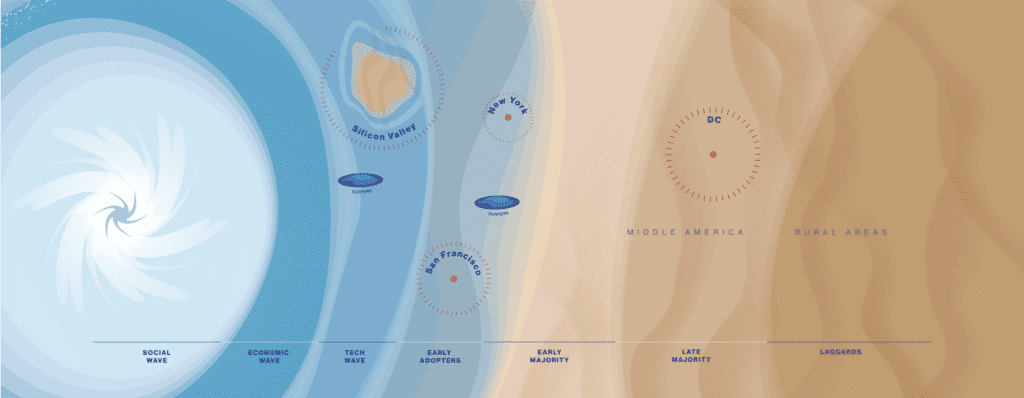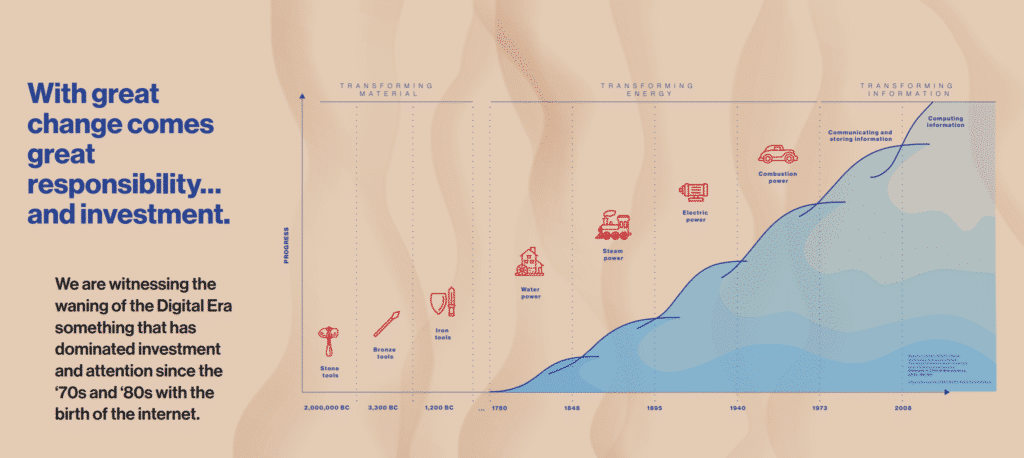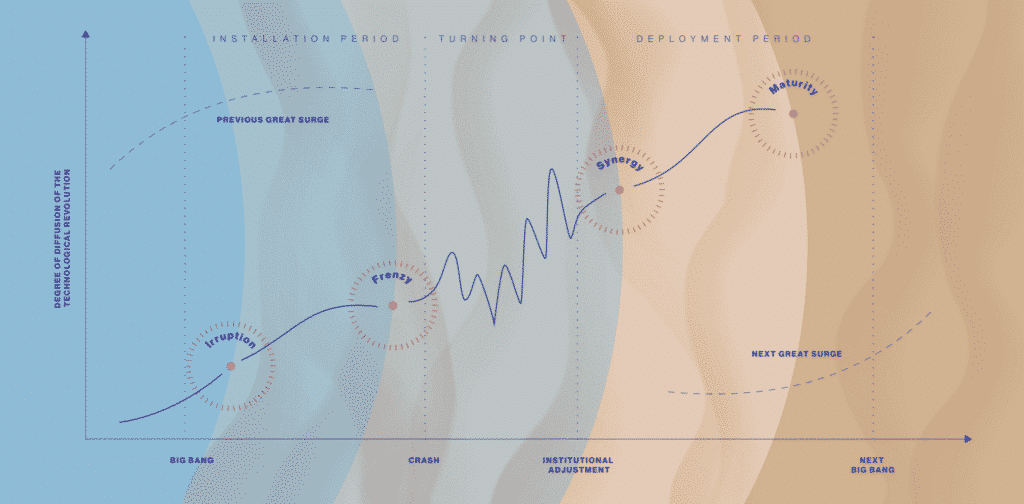“When you first see the leviathan arch of the world’s biggest wave tower over the cliffs… its crown of angry froth exploding onto itself, you might wonder if it isn’t the tongue of God come to swallow the Earth.” – Kristen French, How It Feels to Surf the World’s Biggest Wave
Sink, swim, or surf? As we stand on the precipice of a technological revolution, driven by breakthroughs in Generative AI, Web3, metaverse, quantum computing, and microprocessor engineering, we find ourselves in the midst of a massive storm of disruption, one that will shock societies, industries, and markets alike. We’re calling this storm, and its powerful waves of change, a Hype Cyclone. But to understand, plan for, and shape the direction of these waves, we will need a specific toolkit at our disposal–and of course a lesson in surfing.
How to find and chase a maverick.
Have you ever considered how surfers are able to find the exact location, time, and duration for the next big wave? It’s not just a matter of luck or skill. It’s science.
The invention of wave forecasting was invented by Walter Munk, an American oceanographer and geophysicist. During World War II, while studying underwater acoustics, Munk found that waves directly affected military landing crafts as they approached the beach. By analyzing storms at sea, he predicted when and where giant waves could disrupt amphibious landings. Strong storms create powerful winds that generate massive swells in the ocean. The direction, size, and duration determine the quality of waves that will form when they reach the shore. Surfers cleverly exapted this tool to ride mavericks anywhere in the world instead of chasing them.
Tracking the Hype Cyclone requires a similar process. It is fueled by exponential advances in artificial intelligence, which will cause the rapid advancement of converging, emerging technologies, reorientation of financial markets, and shifts in socio-cultural dynamics. It’s the biggest storm we have seen in generations, and it’s only getting bigger. As we brace for impact, one thing is certain: this storm will wipe out the status quo of existing technologies, capital markets, and socio-cultural norms as we know them.

AI is the next GPT. No, not that GPT: a “General Purpose Technology”.
The recent advancement of Generative AI is just the beginning of a new wave of innovation. The previous wave, the Information Technology (IT) revolution, and the information economics generated from it, culminated in the digital transformation of the business landscape as we know it. We can already see Generative AI will make the .com boom pale in comparison. It will transform from mere hype into the next General Purpose Technology. Mass exposure is already reorienting attention, perception, and funding for AI projects, while the rate of adoption is outpacing any technological innovation in human history. But here’s the mind-blowing part: we are witnessing consumer adoption of Generative AI at a greater pace and scale than we saw in the .com boom when AOL burst onto the scene. To quote Justin Trudeau, “The pace of change has never been this fast, yet it will never be this slow again.” But there is a key distinction: in just 2 months ChatGPT reached 100 million users. AOL never even reached 24 million.1 Generative AI has triggered a Cambrian Explosion of innovation, and this is just the beginning.
This level of adoption and capital frenzy has predictably created hype on a grand scale. Excitement, fear, uncertainty, doubt, optimism…you name it. With articles spewing everything from sentient search engines to charlatans fearmongering in the depths of YouTube, it’s no wonder people are feeling concerned.2 Waves are already hitting the shore in the form of applications like ChatGPT, but tsunamis are soon to follow. If Amara’s Law is any indicator, we will likely overestimate the effect this technology has in the short run, and drastically underestimate its effects in the long run.3 We believe we must shift our gaze from what is in front of us towards what’s on the horizon in the next half-century. Surf’s up.


With great change comes great responsibility… and investment.
The Digital Era is waning. It’s one that has dominated investment since the birth of the microchip, the personal computer, and the internet. This Hype Cyclone will generate larger and more powerful waves over the coming decades, and Generative AI is merely the first. As Azeem Azhar has pointed out, we’re in the dawning of the Exponential Age of innovation.4 As the cost for development becomes cheaper and capabilities expand faster and more proficiently, investment in AI will rapidly increase. This begs the question, what kind of impact will this have on us?
Impact will be centered on the technology sector and early adopters first. They will wrestle with implications, develop new technologies, and offer solutions for integrating this technology into the future of work. From there, it will hit global economic structures, impacting financial markets, jobs, wages, and much more. It will then spill over into our sociocultural ecosystems. Everything from politics to pop culture will be impacted by these new technologies and eventually our world will look drastically different. As organizations and VC’s pour investment into artificial intelligence, start-ups will push the boundaries of possibility and entrepreneurs will seek to carve out their slice. It’s no secret that the major surge of innovation will be funded by those who believe that the future looks different than the past.
The ramp up is already highly capitalized. The promise of AI has captured the imagination of leaders and investors alike. According to a report by Fortune Business Insights, the global AI market size is projected to grow from USD 387.45 billion in 2022 to USD 1,394.30 billion by 2029. This represents a CAGR of 20.1.4 With exponential technologies comes unprecedented investment. The current hype will ultimately drive more investment, which will drive deeper innovation, which will change institutions, which will usher in the next revolutionary advancements in technology innovation. Let that digest for a second. It’s a cyclical pattern we’ve seen before, and it won’t be the last.
The good news: history doesn’t repeat itself, but it does rhyme.

Carlota Perez, a leading scholar in the field of technological revolutions, claims these transformative periods follow a cyclical pattern that lasts around 50 to 60 years. This pattern consists of four key phases that fall within two distinct periods.
The first is the Installation Period, when technology and financial capital combine to disrupt entire industries of the previous age. However, within this period there are two phases. The Irruption Phase, where funding for innovation sparks new inventions and industries, and the Frenzy Phase, where speculation, financialization, and general hype inflate asset bubbles.
After the Installation Period runs its course, a Turning Point occurs, which is marked by financial crashes and recoveries. At this point, businesses adapt to the new means of production, or fall by the wayside as other companies overtake their position. This leads to winners and losers and disenfranchisement of workforces.
The upheaval in the Turning Point can be disastrous, leading to wars, revolutions, and extreme political swings. But eventually, governmental systems begin to catch up to and work with these technological developments, bringing about a Deployment Period and a “golden age” of political, technological, and socio-cultural harmony. The first phase of the Deployment Period is the Synergy Phase, where political regulation and consolidation potentially repair the link between financial and production capital. Subsequently, we reach the Maturity Phase, where technology becomes saturated and idle capital moves to new sectors. And the cycle repeats.6
While we assert that this new cluster of innovation represents a fundamental acceleration of human progress, we believe that this wave of innovation will hold true to Perez’s cycle because of one critical factor: humanity itself. The biggest barrier to progressing longer cycles that are free of crashes lies in the evolutionary limitations rooted in our biological and sociological nature. From the biological standpoint, it is our hypothesis that the reason these cycles occur over these 50–60-year periods are due in part to our lifespan. We simply don’t live long enough to bring the lessons of our past into future decision-making. Humanity has a short memory. From the sociological standpoint, we are frightened of the unknown, and therefore resistant to uncertainty. The faster the pace of innovation, the bigger the pushback. We tend to conflate uncertainty with risk.
Welcome to the Irruption Phase. Now here’s how to navigate it.
No phase of technological advancement produces a more volatile, uncertain, complex, and ambiguous (VUCA) situation than the Irruption Phase. However, with the right tools, we can plan for and conceptualize the future.
First, we need to view this new cluster of innovation through the lens of the Adjacent Possible, our framework that determines potential near-future developments based on a rigorous pattern analysis of current knowledge, resources, and technologies. Think of this as our sophisticated storm tracker that will guide organizations and innovators through the Hype Cyclone’s cone of uncertainty. It can help us find the right waves to surf, which ones to shape, and which ones to avoid. The Adjacent Possible framework allows us to explore new territory by mapping the array of implications that breakthroughs create. Each breakthrough can open a multitude of possibility spaces.
By narrowing down scenarios, we have the opportunity to calculate the directions that shape the future. The Adjacent Possible is our tool for understanding where, when, and how large these waves will be. It will allow us to understand the patterns within these clusters of innovation and determine the paths they can take. Through this modeling tool, we can narrow down the Possibility space to Plausible and Probable futures, and most importantly, we can define what a Purposeful path forward looks like. It’s an innovation toolkit for chasing mavericks.
The Adjacent Possible framework serves as an organization’s storm tracker that provides a set of patterns to anticipate the large number of possibilities. It narrows them down to a number of distinct probabilities that will shape innovation strategy. But we need another tool to ultimately shape our futures towards the Purposeful future we want most. We like to think of it as Jack Sparrow’s compass, it doesn’t necessarily need to point north, it needs to point where our hearts and minds most desire for our organizations. An organization’s Purpose serves as this compass. Organizations can use Purpose as the guiding tool that will move us towards a future we actually want to live in. In the right hands, with the right crew, and the right backing, we can shape the future, guiding where we want to land.
It is essential to understand that predictive tools are useless without Purpose. Purpose is at the intersection of who an organization is and the need in the world they are uniquely positioned to solve. Having a clear sense of this Purpose will guide decision-making, strategy, and, of course, innovation. As organizations and companies prepare for the coming storms, Purpose is the most important tool to navigate and thrive amidst uncertainty.
By investing in a Purpose-driven path, organizations have the power to shape and change the trajectory of the future for good, not just for profit.
We cannot ride just any wave; we need to consciously choose the right ones. With the tools we have outlined, we can map the storm, surf the waves, and stay the course towards a Purposeful Protopian future. This demands a strategy.
Think of strategy as the dams, dikes, and flood panels coastal engineers build to control flooding and shape the impact of water surges. With the right strategies in place, we can direct the impact to our benefit. The challenge for leaders will be to align strategy and innovation initiatives with Purpose in order to ensure their organizations can not only survive but thrive amidst rapidly changing market conditions.
The Hype Cyclone is here.
Having the right tools, foresight, and conviction to pave a path forward will move us towards a new golden age of proactive, Purpose-driven, and protopian future.
Download this white paper as a PDF.
Sources: